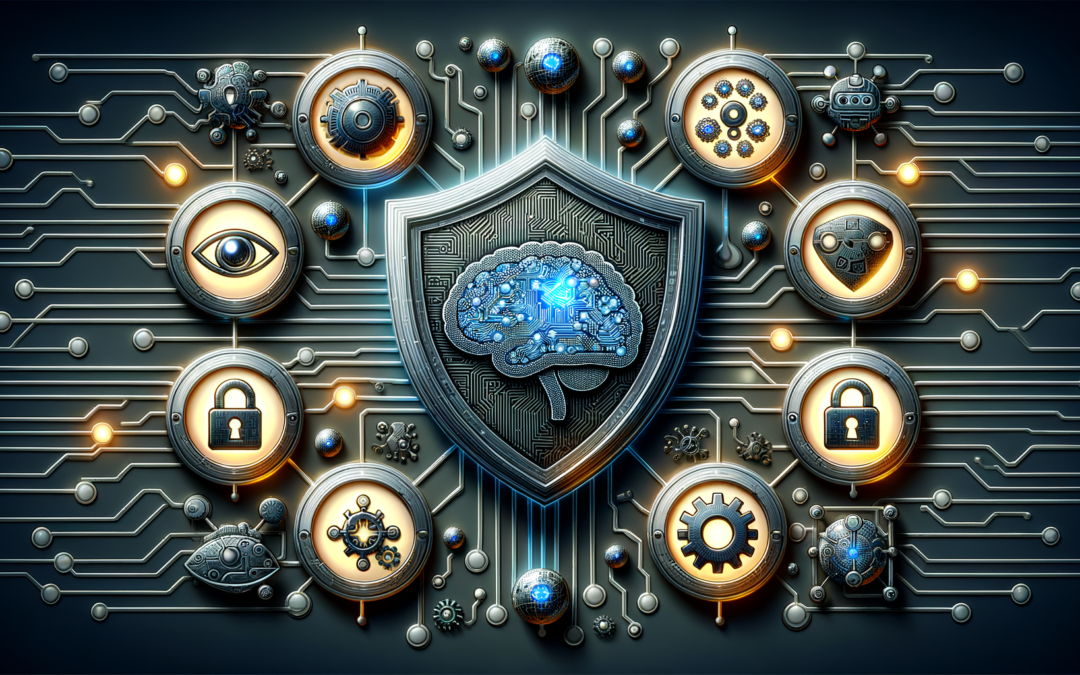Table Of Content

The U.S. government recently unveiled new security guidelines focused on safeguarding critical infrastructure against AI-related threats. These guidelines are a result of a comprehensive effort to assess AI risks across various sectors and address potential vulnerabilities and misuse of AI technology.
Overview of AI Security Guidelines
As I delve into the realm of AI security guidelines, it’s crucial to understand the purpose behind them. The recently released guidelines by the U.S. government aim to reinforce critical infrastructure against the evolving threats posed by artificial intelligence (AI).
The collaborative efforts involved in formulating these guidelines are commendable. The Department of Homeland Security (DHS) has coordinated a comprehensive whole-of-government approach to assess AI risks across all sixteen critical infrastructure sectors. These guidelines address threats emanating from AI systems and those that target them, emphasizing the need for transparency and secure design practices.
One of the primary focus areas of these guidelines is to manage AI-related risks effectively. To achieve this, four key functions have been outlined:
- Establish an organizational culture of AI risk management: It is essential for entities to embed a proactive approach towards identifying and mitigating AI risks.
- Understand your individual AI use context and risk profile: Recognizing the specific context in which AI is utilized and evaluating associated risks is crucial for effective risk management.
- Develop systems to assess, analyze, and track AI risks: Implementing robust mechanisms to continuously monitor and evaluate AI risks enables proactive risk mitigation.
- Prioritize and act upon AI risks to safety and security: Identifying and prioritizing AI risks ensures that resources are allocated efficiently to address the most critical threats.
It is imperative for critical infrastructure owners and operators to tailor these guidelines to their sector-specific and context-specific AI applications. By understanding dependencies on AI vendors, entities can effectively collaborate to mitigate potential risks and enhance their overall security posture.
The development of these guidelines comes at a significant juncture, following the release of a cybersecurity information sheet by the Five Eyes Intelligence Alliance. The document highlighted the necessity for stringent measures while deploying AI systems to curb potential exploitation by malicious actors.
In the current landscape, the security of AI systems remains a top priority due to the burgeoning threats posed by prompt injection attacks and model inversion techniques. The guidelines recommend best practices such as securing deployment environments, source code reviews, and rigorous validation processes to safeguard AI systems from vulnerabilities.
As we navigate the complex terrain of AI security risks, adherence to these guidelines becomes paramount to mitigating the potential impact of adversarial activities in the AI domain. Stay tuned for more insights into addressing AI-related risks in critical infrastructure.
Key Recommendations for Critical Infrastructure Owners
As a critical infrastructure owner, it is essential to prioritize the security and safety of your systems against potential AI-related risks. Based on the latest guidelines released by the U.S. government, there are key recommendations that can help enhance AI risk management within your organization.
- Establishing an Organizational Culture of AI Risk Management:
- One of the fundamental steps to safeguarding critical infrastructure is to cultivate a culture within the organization that values and prioritizes AI risk management. This involves ensuring that all stakeholders understand the importance of identifying and mitigating AI-related threats.
- Understanding Individual AI Use Context and Risk Profile:
- Each AI system utilized within the critical infrastructure may have unique use contexts and associated risk profiles. It is crucial to delve deep into the specifics of how AI is being used in various operations to comprehensively assess the potential risks it poses.
- Developing Systems to Assess and Track AI Risks:
- Building robust systems that can effectively assess, analyze, and track AI risks is crucial for maintaining the security of critical infrastructure. These systems should be designed to continuously monitor and evaluate any potential risks stemming from AI deployment.
- Prioritizing and Acting Upon AI Risks to Safety and Security:
- Once AI risks have been identified and assessed, it is imperative to prioritize them based on their potential impact on safety and security. Taking prompt and decisive action to mitigate these risks can help prevent any adverse consequences.
Addressing AI Risks and Mitigations
As someone deeply involved in the realm of AI security, I understand the critical importance of addressing risks and implementing effective mitigations in the face of evolving technologies. The recent release of new AI security guidelines by the U.S. government marks a significant step towards fortifying critical infrastructure against AI-related threats. These guidelines are a result of a comprehensive assessment conducted across all sixteen critical infrastructure sectors, reflecting a holistic approach to managing AI risks.
The Department of Homeland Security (DHS) emphasizes the need to address threats posed by the use of AI to augment and scale attacks on critical infrastructure. This includes concerns regarding adversarial manipulation of AI systems and recognizing potential shortcomings that could lead to unintended consequences. Transparency and secure-by-design practices are highlighted as essential measures to evaluate and mitigate these risks effectively.
The guidelines outline a structured approach consisting of four key functions that cover various aspects of the AI lifecycle:
- Govern: Establishing an organizational culture focused on managing AI risk effectively.
- Map: Understanding the specific context and risk profile of individual AI usage.
- Measure: Developing systems to assess, analyze, and track AI risks systematically.
- Manage: Prioritizing and taking action on AI risks to ensure safety and security.
It is crucial for critical infrastructure owners and operators to tailor their approach by accounting for sector-specific nuances and context-specific use of AI when assessing risks and selecting appropriate mitigations. Understanding dependencies on AI vendors and clearly defining mitigation responsibilities are key steps in this process.
The release of these guidelines comes in the wake of a cybersecurity information sheet from the Five Eyes Intelligence Alliance, underscoring the meticulous setup and configuration required for deploying AI systems securely. rapid adoption of AI capabilities has made these technologies lucrative targets for malicious cyber actors, necessitating robust security measures to protect against potential threats. Best practices include securing the deployment environment, validating AI systems, enforcing access controls, conducting external audits, and maintaining robust logging practices.
Failure to adhere to stringent security measures can lead to severe consequences, such as model inversion attacks and the corruption of AI models, posing risks of cascading downstream impacts. Recent incidents, including vulnerabilities in neural network libraries and prompt injection attacks, highlight the evolving landscape of AI security threats.
As we navigate these challenges, it is imperative to stay vigilant, adapt to emerging threats, and continuously evolve our security measures to safeguard critical infrastructure against AI-related risks. By adopting a proactive approach and implementing the recommended guidelines, we can mitigate vulnerabilities and ensure the safe and responsible use of AI technologies.
Implications and Future Considerations
As someone deeply immersed in the realm of AI security, it’s crucial to acknowledge the far-reaching implications of non-compliance with security measures. The potential consequences of AI system vulnerabilities cannot be underestimated, especially when it comes to critical infrastructure.
Failure to adhere to robust security measures can lead to severe repercussions, allowing malicious actors to exploit vulnerabilities and compromise AI systems. This could result in devastating outcomes, such as staged model inversion attacks and the corruption of AI models to disrupt expected behaviors, triggering cascading downstream impacts.
Looking ahead, it’s essential to consider future strategies to enhance AI security in critical infrastructure. One key aspect is to establish a robust organizational culture of AI risk management, ensuring a comprehensive understanding of individual AI use contexts and associated risk profiles. Developing systems to assess, analyze, and track AI risks, as well as prioritizing and acting upon these risks, are vital steps toward safeguarding AI systems.
Transparency and security by design practices play a pivotal role in evaluating and mitigating AI risks. Embracing best practices such as securing deployment environments, reviewing AI model sources and supply chain security, and enforcing strict access controls are imperative. Additionally, conducting external audits and implementing robust logging mechanisms can fortify AI systems against potential threats.
In conclusion, the journey towards enhancing AI security in critical infrastructure is multifaceted. By proactively addressing security vulnerabilities, prioritizing risk management, and embracing transparency and best practices, we can bolster the resilience of AI systems and safeguard critical infrastructure for a more secure future.
TL;DR:
Non-compliance with AI security measures can have severe consequences, including staged attacks and model corruption. Future considerations involve establishing a culture of risk management, prioritizing AI risk assessment, and implementing robust security practices to fortify critical infrastructure against potential threats.
To learn more about safeguarding critical infrastructure against AI threats, Contact us today!
Link to original article: https://thehackernews.com/2024/04/us-government-releases-new-ai-security.html



